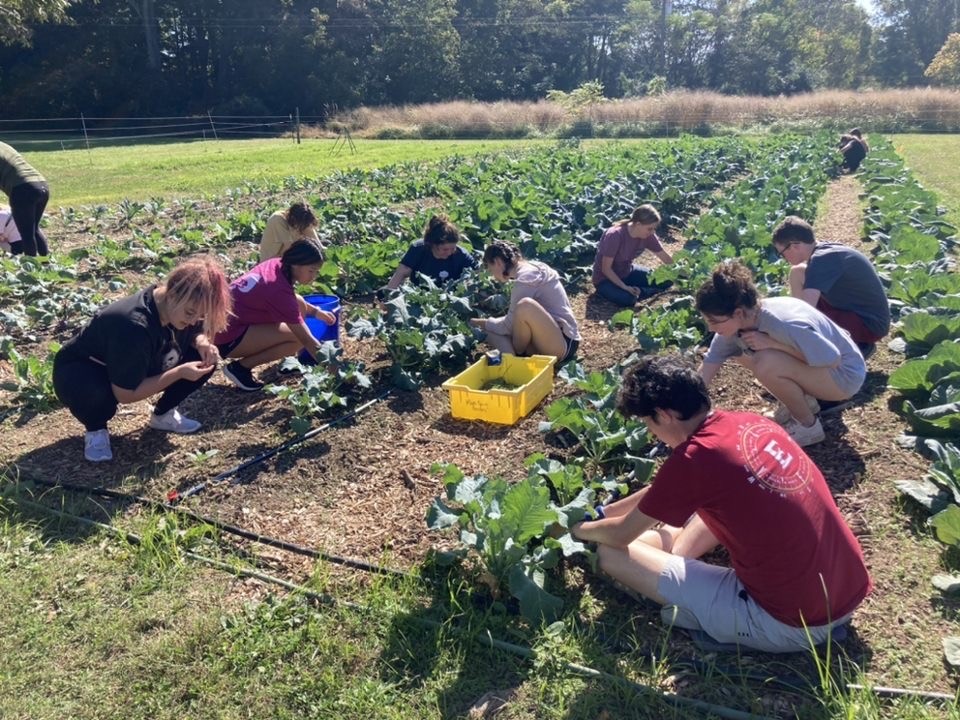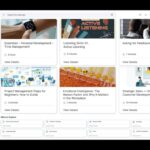Immersive learning in education is a transformative approach that goes beyond traditional teaching methods. At LEARNS.EDU.VN, we believe that immersive learning creates engaging, real-world experiences that foster deeper understanding and skill development. Explore how this dynamic educational approach can revolutionize learning, offering a multitude of benefits and practical applications that redefine the educational landscape. Discover the power of experiential education, situated cognition, and authentic assessment for a truly enriching learning journey.
1. Understanding Immersive Learning: Definition and Scope
Immersive learning isn’t just a singular teaching method or a specific practice; it’s a broad, encompassing approach to education. It’s not tied to any particular subject, course, or future profession. Instead, it’s a holistic philosophy that emphasizes certain core elements to create a powerful learning environment. While the concept isn’t rigidly defined in academic literature, immersive learning generally refers to in-person, experiential educational practices.
It can take many forms, such as learning a new language through a homestay immersion program, gaining hands-on professional skills through internships or clinical placements, or exploring a subject within a different cultural context through global learning or community engagement programs. This approach is found in common educational experiences but also in more specialized practices like healthcare simulations where students learn in realistic, controlled environments.
Immersive learning can also involve structural changes within educational institutions, like using short, intensive courses or “block” models, where students focus on one subject intensely for a short period. While the term “immersive learning” is sometimes used to describe virtual learning experiences, this discussion focuses on in-person, real-world applications.
The following sections will outline six key characteristics of immersive learning practices. This is a flexible and evolving definition intended to describe the essence of in-person, real-world immersive learning.
2. Key Characteristics of Immersive Learning
To truly grasp “What Is Immersive Learning In Education,” we must explore its defining characteristics. These elements work together to create a learning environment that promotes deep engagement and lasting understanding.
2.1. Time and Focus
Time plays a crucial role in learning. How time is managed affects how deeply students can engage with the material. Factors to consider include:
- Degree of Focus: This refers to the amount of attention a student can dedicate to a specific task without distractions. Immersive learning minimizes cognitive overload, enabling students to concentrate on a single task or topic for extended periods. Research indicates that a focused learning environment significantly enhances knowledge acquisition and retention. For example, a study by Soares (1998) highlighted the importance of reducing competing tasks to improve learning outcomes.
- Time on Task: This is the amount of time dedicated to a learning activity. Longer, sustained periods of engagement are generally more effective than shorter ones. According to Gullatt (2006) and van Gog (2013), extended time on task allows for a more thorough exploration of the subject matter.
- Continuity of Learning: This refers to the frequency and consistency of learning experiences. Regular, closely spaced learning sessions can promote deeper understanding and retention compared to infrequent sessions with long gaps. A class that meets daily offers a more connected learning experience than one that meets only twice a week. Continuous exposure helps embed the material in the learner’s mind, moving beyond superficial understanding.
These three elements are interconnected aspects of time that contribute to the overall effectiveness of immersive learning.
2.2. Authentic and Situated Learning
Authenticity and situatedness are vital in immersive learning.
- Authenticity refers to the level of direct, tangible engagement a learner has with real-world tasks and contexts (Hill & Hannafin, 2001; Herrington & Herrington, 2006). Authentic learning experiences allow students to learn in environments that closely resemble those relevant to their field of study. The closer the experience is to the actual content and context, the greater the impact on the student’s understanding.
- Situated Learning suggests that learning is inherently tied to the context in which it occurs (Lave & Wenger, 1991). Students are actively involved in the learning process, connecting with communities and collaborating with peers (Wenger, 2003). Learning is participatory, engaged, and connected to real-world experiences. For instance, learning about car engines is more effective when examining a real engine in a car rather than just using visual aids in a classroom.
Ideally, authentic learning involves:
- Tasks that are as real as possible.
- Learning in environments directly linked to the material being learned.
- Direct engagement with people and communities relevant to the task or environment.
Authentic learning fosters higher-order thinking skills, such as analysis, application, and synthesis, moving students beyond simple memorization.
2.3. Autonomy and Agency
Immersive learning empowers students by giving them control over their learning.
- Autonomy: In immersive settings, students often have more choices and control over how they learn (Werner & McVaugh, 2000). They may need to make decisions independently or seek guidance from sources other than the instructor. This fosters developmental growth and intrinsic motivation (Smith, 2003, 2008).
- Agency: This refers to a student’s ability to realize their power and control over a situation (Klemenčič, 2015). Immersive learning encourages students to connect their actions to outcomes, realizing their influence over their learning process. They become active participants rather than passive recipients (Vaughn, 2020).
2.4. Cognitive Dissonance
Learning can be a disruptive process that challenges our worldview (Mezirow, 1978). Cognitive dissonance occurs when we encounter content or experiences that conflict with our existing beliefs (Hoskins, 2013). Some level of dissonance may be necessary for transformative learning.
Immersive learning, by involving students in authentic settings, tasks, and communities, can increase the potential for dissonance (Dinani, 2018). Experiences like study abroad, internships, and community-based learning can challenge students’ assumptions and beliefs.
2.5. Reflection
Reflection is essential to process immersive experiences and connect them to broader learning and the world (Brookfield, 2016). The authentic learning conditions, increased autonomy, and potential for dissonance require instructors to help students navigate difficult realizations and changes in their knowledge.
Reflection can take many forms (Sturgill & Motley, 2014), but the heightened levels of student autonomy, agency, and engagement with dissonance benefit most from guided and facilitated reflective practices (Hartman et al., 2018).
2.6. Facilitation and Guidance
Due to the variable nature of immersive experiences and the potential for dissonance, skilled facilitation and guidance are crucial (Margalef & Roblin, 2016). Authentic, place-based settings can effectively connect theory to real-world practice, but this can be a complex experience. Facilitators must orient and guide students, ensuring the learning environment aligns with desired outcomes (Guskey, 2014).
A facilitator acts as a “guide on the side” and a co-learner, managing the control ceded during the immersive learning process (Rogers, 1969).
3. The Intensity of Immersive Learning
While the definition of immersive learning emphasizes the presence of all six qualities, the intensity of each quality can vary. Each quality exists on a spectrum from low to high, and different learning experiences may draw from these qualities in varying degrees.
Consider two service-learning courses: one local and one global. In a local course, students might partner with a nearby nonprofit, working autonomously and experiencing dissonance while spending focused time in an authentic setting. In a global service-learning course, students might spend more time on the learning task, focus more deeply, act more autonomously, and encounter increased cognitive dissonance due to cultural differences.
Analyzing and assessing the ranges of these qualities can be useful both after the learning experience and in planning for student learning needs. Visualizing potential intensity levels can help instructors anticipate the impacts of a specific practice and prepare accordingly.
4. Is Immersive Learning a High-Impact Practice?
The question of whether immersive learning is a distinct high-impact practice (HIP) (Kuh, 2008) is open to interpretation. Immersion is often a component of other HIPs like internships, service learning, community-based learning, and global learning. It can also enhance practices such as undergraduate research, learning communities, or capstone projects.
Immersion can act as a “force multiplier,” bridging separate HIPs. For instance, global service-learning combines diversity/global learning with service learning/community-based learning, with immersion amplifying the value of direct learning and community engagement.
If arguing for immersive learning as its own HIP, it would be based on providing students with opportunities for engagement in authentic tasks, communities, and settings. The authentic nature of the learning scenario and the opportunity for students to operate with higher levels of autonomy and agency are key distinguishing factors.
5. Research-Informed Immersive Learning Practices
Immersive learning is a newly defined field, but the practices it encompasses are not. Many of these practices can be organized differently, and some may fit into multiple categories depending on the primary desired outcome.
- Community-Based Learning: This involves interactions with the community, including service learning, social innovation, and teacher education.
- Global Education: This combines disciplinary learning with intercultural learning, such as study abroad and study USA programs.
- Hands-On Research Practice: This connects disciplinary learning to real-world contexts, including field research, teacher education practicums, and community-based research.
- Work-Integrated Learning: This focuses on engaging students with authentic professional settings and tasks, including internships, co-op programs, and clinical rotations.
- Simulated Learning: This takes place in designed environments that mimic real-world professional settings, including role-playing, standardized patients, medical simulations, and flight simulators.
- Combinations of High-Impact Practices: This combines multiple immersive learning practices, such as community-based participatory research and international or global service learning.
- Structural Modifications: This involves strategic manipulation of course structures to address issues of time, focus, and continuity, such as block scheduling and hybrid structures. Institutions like Colorado College and the University of Montana Western use full block curricula, while Guilford College combines single-course blocks with longer semester-like terms.
6. Future Directions: Research, Practice, and Theory
Further research is needed to understand the benefits of immersive learning for students and how to explain these benefits to teachers. The impact of immersive learning on community partners, preceptors, and internship coordinators also warrants further investigation.
Additionally, research should explore the views of current and graduated students on immersive learning practices. Understanding the challenges within higher education structures that prevent the adoption of immersive practices is also crucial.
Encouraging a broader adoption of immersive learning requires identifying necessary support and resources. This includes persuading faculty to cede control over some learning opportunities and demonstrating that the potentially messy aspects of immersive learning can enhance deep learning.
7. Key Scholarship in Immersive Learning
Finding literature that explicitly addresses immersion as a component of high-impact learning can be challenging. While some sources deal with immersion directly, they are often narrowly framed. Locating literature focused on specific pedagogies or HIPs, such as study away or community-based learning, or addressing defining components like authentic engagement and situated learning, can provide valuable insights.
8. Model Immersive Learning Programs
- Block Curriculum: Colorado College and the University of Montana Western implement full block curricula, offering courses exclusively through block terms.
- Elon University: Interactive Media “Fly-In” Course: This global service-learning course allows students to practice skills in professionally and interculturally challenging environments.
- UC-Riverside School of Medicine: LACE Program: This program provides hands-on, experiential learning with early and sustained patient care involvement.
- Purdue University: HDFS Internship Program: This capstone experience provides an immersive, applied experience in a Human Development and Family Studies-related context.
9. Examples of Immersive Learning in Action
| Immersive Learning Activity | Description | Key Characteristics Emphasized |
|---|---|---|
| Medical Simulation | Students practice surgical procedures on realistic mannequins, receiving immediate feedback in a controlled environment. | Authenticity, Time on Task, Facilitation and Guidance |
| Archaeological Field School | Students excavate and analyze artifacts at a historical site, contributing to ongoing research while gaining hands-on experience. | Authentic and Situated Learning, Autonomy, Reflection |
| Business Strategy Simulation | Students manage a virtual company, making decisions about production, marketing, and finance in a competitive market. | Time and Focus, Autonomy and Agency, Reflection |
| Language Immersion Trip | Students live with host families in a foreign country, attending language classes and engaging in daily life activities. | Authenticity, Cognitive Dissonance, Time on Task |
| Mock Trial Competition | Law students prepare and present arguments in a simulated courtroom setting, experiencing the dynamics of legal proceedings firsthand. | Authenticity, Time on Task, Reflection |
| Environmental Restoration Project | Students work with local organizations to restore a degraded ecosystem, planting trees, removing invasive species, and monitoring water quality. | Authentic and Situated Learning, Autonomy, Reflection |




10. Overcoming Challenges in Implementing Immersive Learning
| Challenge | Strategies to Overcome |
|---|---|
| Faculty Resistance | Provide professional development, showcase successful case studies, and offer incentives for innovation. |
| Logistical Complexities | Streamline administrative processes, develop clear guidelines, and establish strong partnerships with external organizations. |
| Resource Constraints | Seek grant funding, leverage existing resources, and prioritize cost-effective approaches. |
| Assessment Difficulties | Develop authentic assessment tools, incorporate reflection activities, and involve stakeholders in the evaluation process. |
| Ensuring Equity and Inclusion | Provide support services, address potential barriers, and promote culturally responsive practices. |
11. LEARNS.EDU.VN: Your Partner in Immersive Learning
At LEARNS.EDU.VN, we are dedicated to providing resources and support for educators and learners interested in immersive learning. We offer a wide range of articles, courses, and tools designed to help you create and participate in meaningful immersive experiences.
12. The Future of Education: Embracing Immersive Learning
Immersive learning represents a paradigm shift in education, moving beyond traditional models to create dynamic, engaging, and transformative experiences. By embracing the principles of authenticity, autonomy, and reflection, we can empower learners to develop the skills and knowledge they need to thrive in a rapidly changing world. Join us at LEARNS.EDU.VN as we explore the endless possibilities of immersive learning and shape the future of education.
Ready to dive deeper into the world of immersive learning? Visit LEARNS.EDU.VN today to discover more articles, courses, and resources that will help you transform your approach to education. Whether you’re an educator looking to create more engaging learning experiences or a student eager to explore new ways of learning, LEARNS.EDU.VN is your ultimate destination. Contact us at 123 Education Way, Learnville, CA 90210, United States, or reach out via WhatsApp at +1 555-555-1212. Let’s embark on this exciting journey together!
FAQ: What is Immersive Learning in Education?
-
What is immersive learning in education?
Immersive learning is an educational approach that creates engaging, real-world experiences to foster deeper understanding and skill development. It goes beyond traditional teaching methods by emphasizing authenticity, autonomy, and reflection. -
How does immersive learning differ from traditional learning?
Traditional learning often relies on passive information absorption, while immersive learning actively involves students in real-world scenarios, promoting critical thinking, problem-solving, and collaboration. -
What are the key benefits of immersive learning?
The benefits include increased engagement, improved knowledge retention, enhanced critical thinking skills, greater autonomy, and a deeper understanding of real-world applications. -
What types of activities are considered immersive learning?
Examples include internships, service learning, study abroad programs, simulations, field research, and community-based projects. -
How can teachers implement immersive learning in the classroom?
Teachers can incorporate real-world case studies, simulations, role-playing exercises, and community engagement projects into their curriculum. -
What role does technology play in immersive learning?
Technology can enhance immersive learning through virtual reality, augmented reality, interactive simulations, and online collaboration tools. -
What is the importance of reflection in immersive learning?
Reflection allows students to process their experiences, connect them to broader learning goals, and develop deeper insights. -
How can schools support immersive learning initiatives?
Schools can provide professional development for teachers, allocate resources for immersive learning activities, and establish partnerships with external organizations. -
What are the challenges of implementing immersive learning?
Challenges include faculty resistance, logistical complexities, resource constraints, assessment difficulties, and ensuring equity and inclusion. -
Where can I find more resources on immersive learning?
Visit learns.edu.vn for articles, courses, and tools designed to help you create and participate in meaningful immersive experiences.
This comprehensive exploration of “what is immersive learning in education” provides a clear understanding of its definition, characteristics, benefits, and practical applications. By embracing immersive learning, educators and learners can unlock new possibilities for transformative educational experiences.
